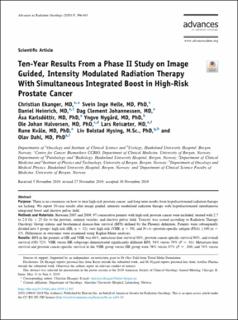Ten-Year Results From a Phase II Study on Image Guided, Intensity Modulated Radiation Therapy With Simultaneous Integrated Boost in High-Risk Prostate Cancer
Ekanger, Christian; Helle, Svein Inge; Heinrich, Daniel; Johannessen, Dag Clement; Karlsdottir, Åsa; Nygård, Yngve; Halvorsen, Ole Johan; Reisæter, Lars Anders Rokne; Kvåle, Rune; Hysing, Liv Bolstad; Dahl, Olav
Journal article, Peer reviewed
Published version

Åpne
Permanent lenke
https://hdl.handle.net/11250/2760989Utgivelsesdato
2020Metadata
Vis full innførselSamlinger
- Department of Clinical Medicine [2066]
- Registrations from Cristin [9791]
Originalversjon
Advances in Radiation Oncology. 2020, 5 (3), 396-403. https://doi.org/10.1016/j.adro.2019.11.007Sammendrag
Purpose
There is no consensus on how to treat high-risk prostate cancer, and long-term results from hypofractionated radiation therapy are lacking. We report 10-year results after image guided, intensity modulated radiation therapy with hypofractionated simultaneous integrated boost and elective pelvic field.
Methods and Materials
Between 2007 and 2009, 97 consecutive patients with high-risk prostate cancer were included, treated with 2.7 to 2.0 Gy × 25 Gy to the prostate, seminal vesicles, and elective pelvic field. Toxicity was scored according to Radiation Therapy Oncology Group criteria and biochemical disease-free survival (BFS) defined by the Phoenix definition. Patients were subsequently divided into 3 groups: high risk (HR; n = 32), very high risk (VHR; n = 50), and N+/s–prostate-specific antigen (PSA) ≥100 (n = 15). Differences in outcomes were examined using Kaplan-Meier analyses.
Results
BFS in the patients at HR and VHR was 64%, metastasis-free survival 80%, prostate cancer-specific survival 90%, and overall survival (OS) 72%. VHR versus HR subgroups demonstrated significantly different BFS, 54% versus 79% (P = .01). Metastasis-free survival and prostate cancer-specific survival in the VHR group versus HR group were 76% versus 87% (P = .108) and 74% versus 100% (P = .157). Patients reaching nadir PSA <0.1 (n = 80) had significantly better outcomes than the rest (n = 17), with BFS 70% versus 7% (P < .001). Acute grade 2 gastrointestinal tract (GI) and genitourinary tract (GU) toxicity occurred in 27% and 40%, grade 3 GI and GU toxicity in 1% and 3%. Late GI and GU grade 2 toxicity occurred in 1% and 8%.
Conclusions
High-risk prostate cancer patients obtained favorable 10-year outcomes with low toxicity. There were significantly better results in the HR versus the VHR group, both better than the N+/PSA ≥100 group. A nadir PSA value < 0.1 predicted good prognosis.
